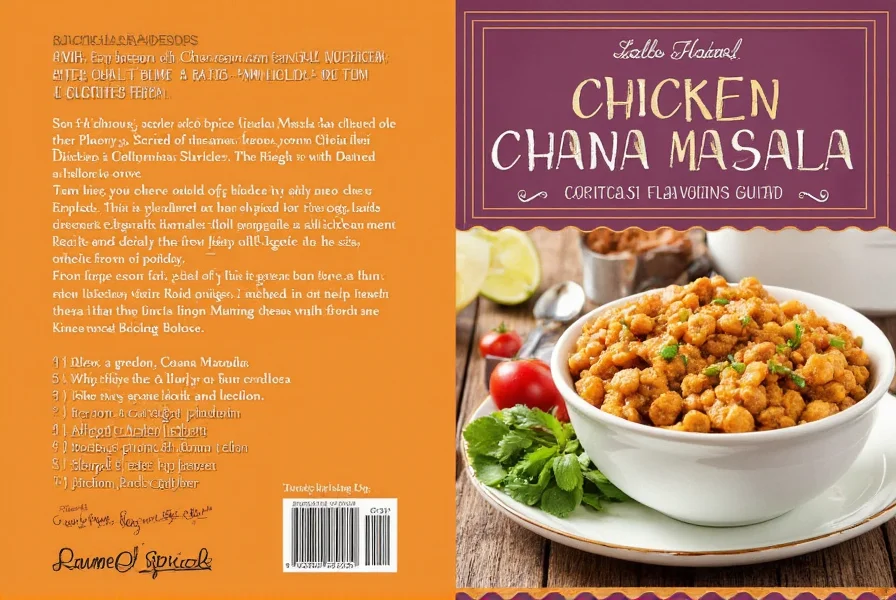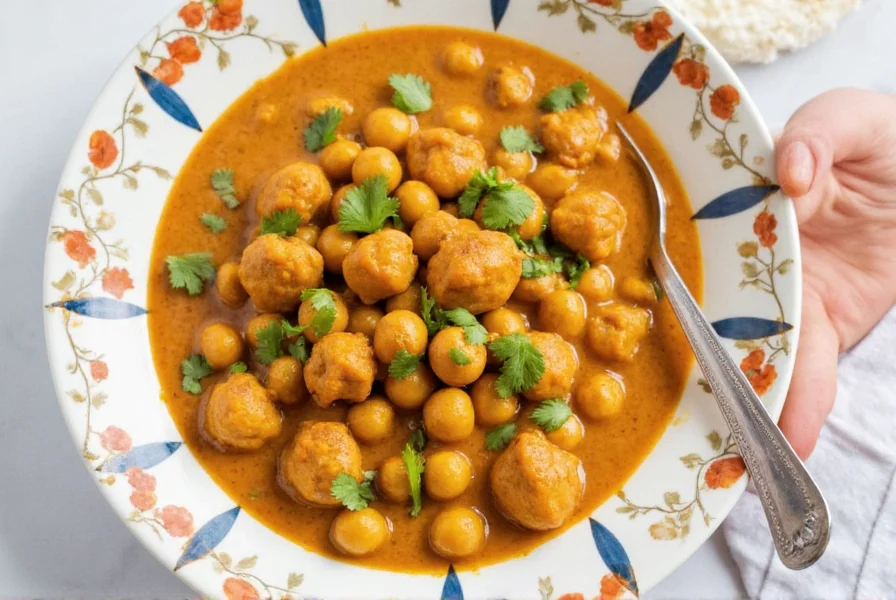Table of Contents
Looking to make authentic Chicken Chana Masala at home? This easy recipe provides everything you need: a complete ingredient list, step-by-step cooking instructions, and expert tips for perfect flavor. With just 30 minutes of preparation and cooking time, you can create a restaurant-quality Indian curry that's perfect for any occasion.

Ingredients
- 2 lbs boneless, skinless chicken thighs, cut into 1-inch pieces
- 2 cans (15 oz each) chickpeas, drained and rinsed
- 2 tbsp vegetable oil
- 1 large onion, finely chopped
- 3 cloves garlic, minced
- 1 tbsp fresh ginger, grated
- 2 tbsp tomato paste
- 1 can (14.5 oz) diced tomatoes
- 1 cup chicken broth
- 1 tsp ground cumin
- 1 tsp ground coriander
- 1 tsp turmeric
- 1 tsp garam masala
- 1/2 tsp cayenne pepper (adjust to taste)
- 1/2 cup plain yogurt
- 1/4 cup fresh cilantro, chopped
- Salt to taste
Instructions
- Prepare the chicken: Pat the chicken pieces dry with paper towels and season with salt.
- Cook the chicken: Heat 1 tbsp oil in a large skillet over medium-high heat. Add the chicken and cook until browned on all sides, about 5-7 minutes. Remove from skillet and set aside.
- Make the base: In the same skillet, add the remaining 1 tbsp oil. Add the onion and cook until softened, about 5 minutes. Add the garlic and ginger, and cook for another minute until fragrant.
- Add spices: Stir in the tomato paste, cumin, coriander, turmeric, garam masala, and cayenne pepper. Cook for 1-2 minutes until fragrant.
- Add tomatoes and broth: Stir in the diced tomatoes and chicken broth. Bring to a simmer.
- Add chicken and chickpeas: Return the chicken to the skillet and add the chickpeas. Simmer for 15-20 minutes until the chicken is cooked through and the sauce has thickened.
- Add yogurt and cilantro: Stir in the yogurt and fresh cilantro. Cook for another 2-3 minutes until heated through.
- Adjust seasoning: Taste and adjust salt and spices as needed.
Spice Basics
At the heart of every great chicken chana masala is a well-balanced spice mix. While the exact combination can vary by region or family recipe, there are a few key spices that are almost always included:
- Garam Masala: Adds warmth and depth to the dish.
- Cumin: Provides an earthy, nutty base.
- Turmeric: Gives the dish its golden color and subtle bitterness.
- Cayenne Pepper: Adds heat without overpowering the flavor.
- Ginger and Garlic: Infuse the dish with pungent, savory notes.
Practical Tips for Making the Best Chicken Chana Masala
Whether you're a seasoned chef or just starting out, these tips will help you master the art of chicken chana masala:
- Use Fresh Ingredients: Fresh ginger, garlic, and tomatoes make all the difference in flavor.
- Toast the Spices First: This enhances their aroma and intensifies their flavor.
- Simmer Slowly: Letting the dish simmer allows the flavors to meld beautifully.
- Adjust the Heat: Add cayenne or chili powder gradually to control the spiciness.
- Add Cream or Yogurt: For a creamier texture and milder taste, stir in a splash of heavy cream or yogurt at the end.
| Item | Features | Advantages | Use Cases | Target Audience | Suitable Occasions |
|---|---|---|---|---|---|
| Ground Cumin | Earthy, nutty flavor | Enhances depth and richness | Base for most Indian curries | Beginners and advanced cooks | Dinner parties, family meals |
| Garam Masala | Warm, aromatic blend | Boosts overall flavor | Final seasoning step | Experienced cooks | Special occasions, celebrations |
| Turmeric | Golden color, mild bitterness | Provides color and subtle flavor | Curries, rice dishes | All levels | Lunch, dinner, snacks |
| Cayenne Pepper | Hot and spicy | Controls heat level | Customizing spiciness | Those who enjoy heat | Weeknight meals, casual gatherings |
| Fresh Ginger | Pungent, zesty | Enhances freshness and sharpness | Marinades, sauces | Everyone | Daily cooking, special recipes |
When buying spices, look for high-quality, freshly ground varieties. Store them in airtight containers away from light and heat to maintain their potency. For the best results, use whole spices when possible and grind them yourself before use.

Frequently Asked Questions
What's the difference between chana masala and chicken chana masala?
Traditional chana masala is a vegetarian dish made with chickpeas in a spicy tomato-based sauce. Chicken chana masala incorporates chicken pieces into the same flavorful base, creating a heartier, protein-rich version of the classic dish.
Can I make chicken chana masala vegetarian?
Absolutely! Simply omit the chicken and you'll have traditional chana masala. You might want to add extra vegetables like potatoes or spinach to maintain the heartiness of the dish.
How long does it take to prepare chicken chana masala?
Preparation takes about 20 minutes for chopping and spice preparation, with cooking time of 30-40 minutes. If using pre-cooked chickpeas, total time is around 50 minutes. Using dried chickpeas that need soaking will add several hours to the preparation time.
What should I serve with chicken chana masala?
This dish pairs perfectly with basmati rice, naan bread, or roti. A side of raita (yogurt sauce with cucumber) helps balance the spices, and a simple salad provides a refreshing contrast to the rich curry.
Can I use canned chickpeas instead of dried ones?
Yes, canned chickpeas work well and save significant time. Just be sure to drain and rinse them thoroughly before adding to the curry. For best results, use two 15-ounce cans to replace 1.5 cups of dried chickpeas.
How can I adjust the spiciness to my preference?
You can easily control the heat by reducing or increasing the cayenne pepper. Start with a smaller amount (1/4 teaspoon), taste as you cook, and add more if needed. Remember that the heat will intensify slightly as the dish simmers.
How long do leftovers keep?
Chicken chana masala tastes even better the next day as the flavors continue to meld. Store in an airtight container in the refrigerator for up to 3-4 days. The dish also freezes well for up to 3 months.
Conclusion
Chicken chana masala is more than just a meal—it's a celebration of flavor, culture, and tradition. With the right spices and techniques, you can bring this beloved dish to life in your own kitchen. Whether you're cooking for yourself, your family, or guests, mastering the basics of spice will open up a world of culinary possibilities. So grab your favorite spices, get creative, and let your taste buds take the lead.
The chicken chana masala is a perfect example of how spices can transform a simple dish into something truly remarkable. It's a testament to the power of flavor and the joy of cooking with passion.












 浙公网安备
33010002000092号
浙公网安备
33010002000092号 浙B2-20120091-4
浙B2-20120091-4